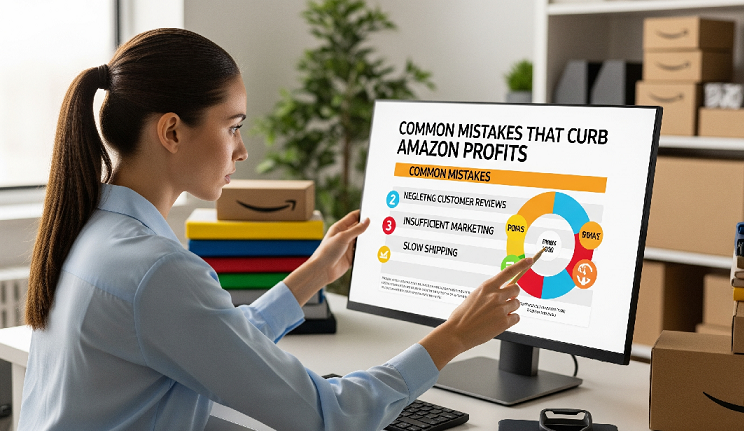Selling on Amazon can be an incredibly lucrative venture, offering access to a massive customer base and a streamlined fulfillment network. However, for every success story, there are countless sellers who struggle to turn a consistent profit. Often, the culprit isn’t a bad product or a lack of effort, but rather a series of common, yet easily fixable, mistakes.
If you’re finding your Amazon profits aren’t quite where you’d like them to be, it’s time to take a critical look at your operations. Let’s dive into some of the most frequent missteps and, more importantly, how to correct them.
1. Underestimated Costs, Underpriced Products
This is perhaps the most fundamental mistake sellers make. Many focus solely on the Amazon referral fee and FBA fees, forgetting a myriad of other expenses.
 Common Cost Oversight:
Common Cost Oversight:
- Shipping to Amazon FBA: The cost of getting your inventory from your supplier or warehouse to Amazon’s fulfillment centers.
- Storage Fees: Especially for slow-moving or oversized items.
- Returns Processing: Amazon charges for handling customer returns.
- Advertising Costs (PPC): Essential for visibility, but if not managed well, can eat into profits.
- Supplier Costs: Negotiating better terms can significantly impact your bottom line.
- Software and Tools: Listing optimization tools, keyword research tools, repricers, etc.
- Taxes: Don’t forget your tax obligations!
How to Fix It:
Implement a rigorous profit margin calculation before you ever list a product. Use a spreadsheet or dedicated Amazon seller tool to track every single cost associated with your product, from sourcing to delivery and beyond. Once you have a clear picture of your true costs, you can set a competitive yet profitable price. Remember, a lower sales price doesn’t always mean more sales if it means you’re selling at a loss!
2. Neglected Keywords, Weak Listings
You might have the best product in the world, but if customers can’t find it, it won’t sell. Many sellers either skip keyword research entirely or do it superficially.

The Mistake:
Relying on generic keywords, stuffing keywords without context, or having incomplete product descriptions and bullet points. This leads to low visibility and poor conversion rates.
How to Fix It:
Invest time in thorough keyword research using tools like Helium 10, Jungle Scout, or even Amazon’s own search bar suggestions. Identify high-volume, relevant keywords and integrate them naturally into your:
- Product Title: Crucial for initial visibility.
- Bullet Points: Highlight key features and benefits.
- Product Description: Provide more detail and reinforce keywords.
- Backend Search Terms: Hidden to customers but vital for Amazon’s algorithm.
Beyond keywords, ensure your images are high-quality, professional, and showcase your product from multiple angles. A+ Content (formerly EBC) for registered brands can also significantly boost conversions.
3. Poor Inventory Management
Running out of stock or, conversely, having too much dead stock, both drain your profits.

The Mistakes:
- Stockouts: Losing sales and organic ranking position when your product is unavailable.
- Overstocking: Incurring higher FBA storage fees, especially for long-term storage, and tying up capital.
- Ignoring Sales Velocity: Not adjusting inventory based on actual sales trends.
How to Fix It:
Implement a robust inventory management system. This could be a simple spreadsheet for smaller operations or dedicated software for larger ones. Regularly analyze your sales velocity, lead times from suppliers, and Amazon’s storage policies. Forecast demand accurately, especially during peak seasons like Prime Day or the holidays. Set reorder points and maintain a healthy buffer to avoid stockouts.
4. Ignoring Customer Feedback and Reviews
Customer reviews are the lifeblood of your Amazon business. Ignoring them is like ignoring free market research and reputation management.

The Mistakes:
Not responding to negative reviews, not actively seeking positive reviews, or failing to address recurring product issues highlighted by customers.
How to Fix It:
Actively monitor your reviews and seller feedback. Respond to all reviews, positive and negative, in a professional and timely manner. For negative reviews, address the customer’s concerns publicly (where appropriate) and offer a solution. Proactively solicit reviews from satisfied customers through Amazon’s request a review button or compliant third-party tools. Most importantly, use feedback to identify flaws in your product, packaging, or listing and make improvements.
5. Inefficient Advertising Spend
Amazon PPC (Pay-Per-Click) is a powerful tool, but if mismanaged, it can quickly erode your margins.

The Mistakes:
Bidding too high on irrelevant keywords, not optimizing campaigns, failing to set negative keywords, or not tracking ACoS (Advertising Cost of Sales).
How to Fix It:
Approach PPC strategically. Start with automatic campaigns to discover new keywords, then transition to manual campaigns for more control. Continuously monitor your ACoS and adjust bids accordingly. Add negative keywords to prevent your ads from showing for irrelevant searches. Test different ad types (Sponsored Products, Brands, Display) and creative. Focus on profitability, not just impressions or clicks.
6. Overlooking Competitor Analysis
The Amazon marketplace is fiercely competitive. If you’re not keeping an eye on your rivals, you’re missing out on vital insights.

The Mistakes:
Not knowing what your competitors are doing well (or poorly), how they’re pricing, what keywords they’re targeting, or what new products they’re launching.
How to Fix It:
Regularly perform competitor analysis. Identify your top 3-5 direct competitors. Monitor their:
- Pricing: Are they consistently lower or higher?
- Keywords: What terms are they ranking for?
- Product Listings: How do their images and descriptions compare?
- Reviews: What are their customers praising or complaining about?
- Advertising Strategies: Are they running aggressive PPC campaigns?
This intelligence can inform your own pricing, product improvements, and marketing strategies, helping you stay ahead of the curve.
Amazon is an incredible platform, but success doesn’t happen by accident. By understanding and actively addressing these common mistakes – from meticulous cost tracking and keyword optimization to smart inventory management and proactive customer engagement – you can significantly improve your profitability and build a sustainable, thriving Amazon business. Start implementing these fixes today and watch your profits grow!








